
Wine Culture and Information since 2002 - Volume 22
 Wine Culture and Information since 2002 - Volume 22 |
|
Issue 11, September 2003 |
Contents |
|
|
DiWineTaste's New Web Site |
|
Just after one year from the publication of the first issue of DiWineTaste, the edition of October 2002 was out in September, we decided to do a new step forward in our editorial activity and the result is the releasing of a new web site as well as the availability of new services for our readers. The first and most important change is about the magazine; besides continuing to be published in Acrobat® PDF format, the magazine will also be available “online” in order to allow the reading of the reports by using a browser and therefore offering another way for our readers to read the magazine. Even back issues are available for “online” reading as well as being available in Acrobat® PDF format, a mean which gives indisputable advantages, in particular for printing, and allows readers to have a copy of the magazine to be read every time and everywhere they wish and in a way no computer would allow. The Acrobat® PDF format is a mean we believe into and we will continue to believe in it, it will not be abandoned, however the availability of an “online” publication offers new possibilities and, we wish so, it will be useful for our readers as they will be able to choose the way and the format which suits their needs and habits best.
In order to allow a better usability of the new site and of reports of every DiWineTaste's edition, in the home page is available a tool which allow to search for one or more specific terms in every document and in every page of the site. Searching for a subject or a specific page can also be accomplished by using the site's index page which displays a complete list, in alphabetical order, of every page available. Like we said, in the back issues page are available all DiWineTaste's issues, both for online reading and in Acrobat® PDF format, besides that, back issues are also available in a single HTML file in order to allow the magazine to be printed from the browser. No matter this latter possibility allows the printing of the whole magazine, we suggest our readers to download the Acrobat® PDF format which is certainly more appropriate for printing. Changes are not just that. We also added a special section dedicated to the service of wine and to its main aspects. The purpose of this section it to provide a quick “handbook” with suggestions and essential information about the service of wine. In this section are currently available specific information about serving temperature, wine glasses as well as an essential list of accessories used for service. At the end of every page of any specific subject are shown some links to other pages useful to anyone who wants to know more and get more information about the subject. We also thought about the “fun” side of wine. Anyone who wishes to test his or her knowledge about the world of wine, hopefully discovering new things in the perfect spirit of the “game”, will find useful using EnoQuiz, a quiz about general and international wine culture. EnoQuiz will show a quiz, every time different, made of ten questions of three difficulty levels: four easy questions, scoring one point each, three average questions, scoring two points each, and three difficult questions, scoring three points each. The result is determined by the score of every question and after having answered every one of them, will be shown the right and wrong answers. Based on the idea behind the “Wines of the Month” column, in the site is available a new service, “Wine of the Day”, which suggests a new wine every day, selected by our editor, chosen among the wines recently evaluated by our tasting committee. A way to let our readers know about the latest wines included in the guide as well as the activity done by DiWineTaste, moreover, a way for suggesting a wine every day. Even “DiWineTaste's Wines Guide” has been improved by adding new information and new suggestions about wines. The most relevant change is about wine detail's form. Besides the information already present, label, name of wine and producer, organoleptic comment and enogastronomical match, it has been added a geographical map where the wine's region of origin is shown, an useful element in order to improve the knowledge about wines as well as having a direct and quick information about wine's origin. Wine detail's form also offer information on how to serve a specific wine. At the end of the form it is suggested the glass and the temperature at which the wine should be served, as well as the possibility of getting more information about these two important aspects. The enogastronomical tool of the guide has been improved as well by getting more flexible and versatile. Besides entering generic foods, now it is also possible to enter the name of recipes or specific ingredients, such as “spaghetti carbonara” or ”eggplant”. Lastly, we also tried to make our wines guide a more complete and useful tool, a reference guide for our readers which already expressed their high appreciation for this service and, we hope so, they will continue to appreciate more and more. We wish this new step will be appreciated by our readers and wine producers, just like all the other things we did in the past. As always we are very glad to receive your comments and your opinions about what we made, in the hope you will help us in offering a better service to you as well as wishing our job to help spreading the right appreciation and culture of wine world. We hope the “surprise” you found at your return from your vacation time will be appreciated and, once again, holding a glass in our hand we certainly look forward to the forthcoming harvest in the hope to fill it with the new results and efforts from every wine producer that, we are certain of that, will be capable of giving us new emotions thanks to their art and mastery. A sincere wish to all wine producers, to the ones who honored us with their trust and preference, and also to the ones who, we hope so, will honor us with their trust. A special wish to our readers as well, even though summer time is almost over, we still have the pleasing thought to know we are having lots of bottles in front of us waiting to be opened and tasted, while reminding, always and anyway, the pleasure of wine is inevitably made of moderation and, last but not the least, by quality. Enjoy browsing DiWineTaste's new web site and enjoy reading the magazine!
|
||||||||||||
MailBox |
|
In this column are published our reader's mail. If you have any comment or any
question or just want to express your opinion about wine, send your letters to
our editorial or fill in
the form available at
our site.
|
| What do you think about the thesis which says the aging of any wine has a negative effect as it inevitably leads to its oxidization? This oxidization may also be useful in hiding any possible defect, which should not be present, anyway, oxidization is a negative effect for the quality of wine and it should not need any aging to improve. Producers who say the wine is not ready and needs aging are just in bad faith because they want to hide wine's faults which should always be at its best at the moment of commercialization. |
| Piero Bellavita -- Bergamo (Italy) |
| Dear Mr. Bellavita, there is one thing we absolutely agree with you: oxidization is a negative effect for the quality of wine. However, it should be remembered that some extraordinary wines, such as Jerez and Marsala, are like that also thanks to the effect of oxidization. During the process of aging of a wine, oxidization is not the only thing happening. Enological chemistry teaches us that other events occur as well, such as reduction, as well as other factors of chemical origin which alter the quality of wine and its components. Aging is not just oxidization. If a mature wine is different from its young equivalent it is also because of these events, result of the patient work of time, which allowed the changes, and changing does not always mean worsening. Moreover it should be considered some wines are purposely made with the specific goal of benefiting of the changes of time, and most of the disciplinary concerning the production of wine require some aging, even years, before releasing the wine on the market. Whether wines should be at their best condition at the time of commercialization is something certainly agreeable and, first of all, honest. It should also be considered that producing wine, in particular quality wine, is an expensive task: keeping a bottle in the cellar for some years waiting for time to make that wine ready to be sold would just increase costs which would be paid by consumers. Lastly, it should be remembered that if it is true certain faults may disappear with time, there are other which get more evident with time, moreover, the magic of time and of aging is a luxury not every wine can afford, indeed, there are wines which are good in their youth and get worse with aging, and this also happens for some prestigious wines. Even youth, as well as other cellar tricks, may be useful in hiding some wine faults that would get evident with time. |
| I heard about some wineries producing organic wine. What is an organic wine? |
| Marvin Lockridge -- Terrell, Texas (USA) |
| Unfortunately, there is still confusion about organic wine and most of the time, prejudices as well. It is wrongly believed organic wine is a sort of inferior wine, made with approximative ways and less modern, therefore having lower quality. Indeed there are many wineries which decided to make organic wine and getting extraordinary results, denying, as a matter of fact, this absurd prejudice. Organic wine is, in general terms, a wine produced without making use of any chemical or synthetic altered pesticide or fertilizer as well as not making use of sulfur dioxide, or at least in little quantities, during the vinification process. However it should be considered every country has specific laws and norms about the production of organic wines which are usually controlled by proper organizations and requirements vary from country to country. For example, in certain countries there are laws about the filtering processes, about materials to be used for bottling, aging and keeping of wine, as well as the prohibition of making use of corks bleached with chemical substances. |
AustriaDespite the fact Austrian wines are not widely known in the world, here they make excellent white and sweet wines; in Austria wine and its production represent a fundamental aspect of the country's culture |
|
Austria is usually considered, according to an enological point of view, similar to Germany, indeed the wines and the enological characteristics of the two countries are very different. Austrian climate is warmer than Germany's, therefore grapes reach a higher ripeness level with the result Austrian wines have more body as well as being drier and having more alcohol, in respect to Austrian taste. In fact, they are completely different wines and in case they have to be compared, it can be said they are more likely to be compared to the wines produced in Friuli Venezia Giulia or Hungary instead of the ones made in Germany. Austria mainly make dry white wines as well as excellent sweet wines which should be considered, undoubtedly, among the best sweet wines of the world.
Austria is currently the eighteenth producer in the world in terms of quantity and the per capita consumption of the country is of about 34 liters (8.9 gallons) ranking eleventh in the world among the wine consuming countries. No matter the scandal of the 1985 hardly compromised the production and credibility of the country as a wine producer, it was discovered most of the wine contained traces of diethylene glycol in order to add body and sweetness, this event turned into an advantage for Austria because they set very strict wine laws and controls became more rigid. Thanks to those laws the giant leap forward of Austria in the quality wine production began and, at last, only quality wineries which were extraneous to the scandal, and always worked for quality, became successful. It is believed were Celts to be the first ones to cultivate vines with the purpose of making wine in the territory where now is located Austria. The cultivation of vine was practiced in those lands by Celts about 500 years before Christ and the production of wine was continued by Romans, particularly fond of the beverage of Bacchus which also was part of their culture, as well as being an essential food for the armies. Culture of vine was particularly practiced by Romans in the Empire's regions of Noricum and Pannonia, located in the south-east area of modern Austria. With the advent of Barbarians, the plains of the provinces of Pannonia were repeatedly devastated by their frequent invasions and only with Charlemagne viticulture resumed its development and spreading, mainly because wine was an essential element for the celebration of Christian Liturgies. Many of the current and best wine areas of Austria originated during those times and their fame continued up to nowadays also thanks to the precious work of monks, in particular in the monasteries near Krems, west from Vienna. Just like in other parts of Europe, the flourishing wine business done by monasteries developed in the middle age and in Austria the most relevant monasteries, belonging to Cistercians, mainly established by monks from Bourgogne, were located in the area of Göttweig, Güssing, Heiligenkreuz, Klosterneuburg, Melk and Zwettl. During the middle age the wine activity in Austria were highly developed and it is believed the area destined to the culture of vine was at least 10 times higher than the current one and Austrian wines were renowned and exported in many European countries. Production increased in the next centuries and it was so high that there were overproductions which required special measures in order to regulate the production of wine. With the constitution of the Hapsburg Empire, which also included Hungary, the renowned wines from Tokay became more famous than the ones produced in the Austrian territory, in particular the renowned Ausbruch wines produced at Rust in the Neusiedlersee-Hügelland area. During the Napoleonic wars, Austrians vineyards were highly damaged, however viticulture resumed its development thanks to the vivid botanic experimentation which also led to the creation of the most renowned Austrian grapes. In 1860 at Klosterneuburg was established the first viticulture and enology school as well as a center for botanic research and experimentation. In 1985 the wine industry of Austria was shocked by a scandal and they discovered most of wine was adulterated with diethylene glycol, a harmless substance however illegal, added with the purpose of increasing body and sweetness of wine, a scandal which also partly affected Germany because they found out some German wines were produced with Austrian wine. Damages to the wine reputation of Austria because of this scandal, led to the promulgation of strict wine laws and nowadays they are considered the most rigid wine laws of the world.
|
||||||||||||
|
Wine laws regulating Austrian quality system are to be considered among the more rigid and strict of any other European country. Laws set exact requisites for every type of wine, including the minimum quantity of sugar in grapes at the moment of harvesting and the highest percentage of alcohol by volume allowed. Moreover disciplinary production define what grapes can be cultivated, the maximum yield per hectare, the possibility of chaptalization, the method of fermentation and precise information that must be written in the label. Moreover, Austrian quality system requires that every wine must be tested and controlled by means of chemical analyses and only in case the result of this test is positive will be issued an official control number. Even composition percentages of wines is more rigid compared to the other countries. In case a wine's label has the name of the vineyard where the grapes were harvested (“ried” in Austrian language), the wine must be exclusively produced with the grapes from that vineyard. The same requisite is needed for wines which label shows specific geographic areas or regions. In case a specific grape or vintage is written in the label, the wine must be produced with at least 85% of the named grape or vintage. The Austrian quality system classifies wines in specific categories which also define the level of quality and the style. It should be remembered a wine in order to belong to a specific category must meet all the minimum requirements as set by law, in particular must density, in Austria measured in Klosterneuburger Mostwage degrees, abbreviated as KMW. The categories set by the Austrian quality system, from the lowest one to the highest, are as follows:
Wines belonging to the Prädikatswein category include the following categories, from the lowest level of must density to the highest:
The area of Wachau, among the most important wine areas of Austria, has its own classification method for wines:
|
|
Wine production of Austria is mainly about white and sweet wines, however in the country are also produced red wines. After the 1985 scandal, quality in Austrian wines has become one of the main goals of any producer and this is certainly confirmed by facts. What could have been seen as a disastrous event with irremediable effects, indeed originated a strong impulse, fundamental and strategic for the wine industry of Austria. In Austria are mainly cultivated white berried grapes where Grüner Veltliner is the most interesting representative. This grape, which is also the most cultivated in the country, is capable of producing unique and extraordinary white wines, with surprising organoleptic qualities; it certainly is a wine to be tried and not to be underrated. The main white berried grapes cultivated in Austria, both used for the production of dry wines and sweet wines, include Grüner Veltliner, Furmint, Chardonnay (known in Styria as Morillon), Pinot Gris, Riesling, Riesling X Sylvaner (which probably is Müller Thurgau), Sämling, Sauvignon Blanc, Traminer, Welschriesling. Among the red berried grapes are cultivated Blauburgunder (Pinot Noir), Blaufränkisch, Cabernet Sauvignon, St. Laurent and Zweigelt. Wine production in Austria is mainly made in the eastern part, from Lower Austria, bordering Czech Republic and Slovakia, bordering the areas near Hungary and Slovenia. The widest area is Lower Austria which include five interesting wine districts and the most important and famous of them all is Wachau. Wine production is Austria in mainly about white wine, which represents about 80% of total production, whereas most of the red wines are produced with Blaufränkisch grape. It should be observed most of Austrian wines are mono varietal, that is produced with one type of grape, however there are also wines produced with more grapes. Here, just like in Germany, white wines are rarely fermented in cask, in Austria they prefer to favor and exalt, rightly, the aromatic characteristics and qualities of grapes. Even tradition plays a fundamental role, in particular for the production of sweet wines, which are still made with techniques developed hundreds years ago.
|
|
Lower Austria is the most important and largest wine area of the country; more than 50% of vineyards are located in this region. Despite the name can make think it is located to the south, the region is in the northern part of Austria, bordering Czech Republic and Slovakia, and goes along the course of Danube river to the eastern part of the country. Vienna, the evocative capital of Austria, no matter is geographically part of this region, is considered as an autonomous wine region. Lower Austria include five wine districts: Donauland-Carnuntum, Kamptal-Donauland, Thermenregion, Wachau and Weinviertel. The most important ones of these five districts are Wachau, Donauland-Carnuntum and Kamptal-Donauland. Wachau, the smallest of the five, is the most important one. Wines produced in this tiny area have quality, elegance and balance hardly found in other districts. It should be observed that in the Wachau area, as opposed to what is set by law for other wine areas, wines are classified according to a system set by the local association of wine producers (Vinea Wachau) which includes three categories: Steinfeder, Federspiel and Smaragd. The most cultivated grapes in this region are Grüner Veltliner and Riesling. In particular, Grüner Veltliner, a local Austrian grape, is capable of producing elegant and pleasing wines having a surprising finishing taste of white pepper. Other grapes cultivated in Lower Austria include Riesling, of which the best wines comes from Wachau, Riesling X Sylvaner (by many considered as Müller Thurgau), Welschriesling, Weissburgunder (Pinot Blanc) and Chardonnay. In this region are also produced interesting red wines, mainly with Blauburgunder (Pinot Noir) and Zweigelt grapes.
|
|
Burgenland is the second wine region of the country in terms of acreage and it is located to the border with Hungary, here are produced the famous and excellent sweet wines of Austria, of which Ausbruch is still among the most celebrated and renowned ones. This particular type of wine is produced with grapes affected by noble rot (Botrytis Cinerea) to which is added fresh and partially botrytised must, following, in this aspect, the production technique used in Hungary for the Tokaji Aszú. The best Ausbruch, as well as the best Beerenauslese and Trockenbeerenauslese, are produced in the northern part of the region, in the Nuesield lake area, called Neusiedlersee by Austrian, and in particular the area of Rust. Climate conditions of the area, thanks to the effects of the lake, allow the development of the noble rot on the grapes, an essential condition for the production of Ausbruch. The grapes mainly used for the production of these wines include Welschriesling, Weissburgunder, Neuberger, Chardonnay, Traminer and Furmint, the grape used for the production of Tokaji Aszú. In this region it is also produced a special and renowned wine with grapes not affected by noble rot: Eiswein. Moreover, the region produces red wines, in particular with Blaufränkisch, Zweigelt and St. Laurent grapes, a cross of Blaufränkisch and Zweigelt. Lastly, it should be remembered in Burgenland are also produced dry white wines, in particular with Chardonnay grape.
|
|
This region is located to the southern part of the country and its wine production in mainly about white wines. The most cultivated grape of the region is Morrilon, the name used in this area to refer to Chardonnay, and it seems it was directly introduced here from the French Champagne. However it is Sauvignon Blanc the grape which probably produces the best wines of Styria, with their herbaceous and fresh aroma, they usually resemble the ones from Sancerre. Other grapes cultivated in this region include Weissburgunder, Welschriesling, Traminer and Muskateller. Styria is also famous for its rose wines, in particular the Schilcher, produced with Blauer Wildbacher grapes cultivated almost exclusively in the western part of the region. Schilcher usually is a rather acid wine, as opposed to what one may expect from a rose wine.
|
|
Vienna, besides being the capital city of Austria, is also an important wine area of the country, and it is the only capital city of the world having this characteristic. In the outskirts of this evocative city are cultivated vineyards whose grapes are used for the production of white wines, including the Gemischter Satz, a traditional wine produced with many grape varieties pressed and vinified together. The main production is about white wines, in particular with Riesling, Weissburgunder, Gewürztraminer and Chardonnay grapes. In this region are also produced red wines, in particular with Zweigelt and Cabernet Sauvignon grapes, as well as an interesting production of sparkling wine made with the classic method.
|
Tasting Sparkling WinesIndisputable stars in moments of celebration, sparkling wines always evoke a special magic which is freed from the glass by means of a continuous chain of transparent pearls and of their appealing aromas |
|
A discrete whisper, but also a sudden bang, in the worst and unwanted cases, and suddenly the attention of everyone is caught by that bottle that more than any other else evokes happy moments and of celebration, with its crystalline liquid often accompanies the important moments of people's life: sparkling wine. The role usually recognized to sparkling wines, that is to be consumed in holidays, is a sort of curse for them but also a huge luck. Few people cannot resist to the charm of a sparkling wine, maybe because its presence in the glass gives people the illusion of living an important moment to which everyone must take part. Since ever the charm of sparkling wines, it would be useless to deny it, in particular Champagne, served in glasses capable of exalting the most mysterious and magic aspect, bubbles, gave people special moments of happiness in the name of that ancient tradition of French noblemen where the availability of Champagne were not a problem at all, and bottles were often and willingly uncorked. Even though it must be said Champagne has the indisputable merit of having allowed bubbles to be famous and looked for in every part of the world, it should be remembered there also are other sparkling wines with excellent quality produced in many wine producing countries. Sparkling wines are not just “bubbles”, their charm is also made by their delicate and refined aromas and, last but not the least, by their refreshing and appealing taste.
|
|
In general terms, every time sparkling wines are taken into consideration, the style referred is always white, as a matter of fact, the most produced and appreciated one, however there also are red sparkling wines, such as the renowned Brachetto. We will not discuss much about the color of red sparkling wines, a factor greatly affected by the grape used for their production, however it can be said the color of these wines always ranges from deep pink to pale red. It should also be remembered there are rose sparkling wines, in particular the ones produced with the classic method, such as Champagne and Franciacorta, real and proper enological pearls, excellent examples of elegance and finesse. In white sparkling wines the color is mainly determined by the grapes used for the production, and in case of classic method wines, by the time spent in contact with yeasts and the aging time after the disgorgement. The color of sparkling wines produced with the Charmat method is usually greenish yellow and in some cases is pale straw yellow with evident nuances of greenish yellow. In white sparkling wines produced with the classic method, the young ones and the ones produced with white berried grapes only, the so called “blanc de blancs”, the color will be pale straw yellow with evident nuances of greenish yellow, anyway a light and pale color is always the sign of a young wine. In sparkling wines produced with red berried grapes and blended with white grapes, the color is usually straw yellow with nuances of golden yellow, whereas in sparkling wines exclusively produced with red berried grapes, the so called “blanc de noirs”, the golden color will be more evident. After disgorgement, because of the effects of oxygen, a slow but inexorable oxidization will turn colors into deeper and darker tints of increasing intensity. In rose sparkling wines the color mainly depends on the quantity of red wine used in the cuvée, usually Pinot Noir, which will give the wine tints ranging from pale pink to intense salmon pink.
|
|
Among the most charming aspects of sparkling wines, among the ones that usually catch the attention the most, is effervescence, the continuous and joyous fountain of bubbles which emerges to the surface from the bottom of the glass. Bubbles are usually a clear sign about the quality of a sparkling wine as well as the quality of the production technique, however also froth plays an important role in the appearance evaluation of these wines. The substance responsible for the formation of these two factors, froth and bubbles, is carbon dioxide (CO2) which is formed during production, whereas the development is regulated by physical factors that take place in the glass, in particular the temperature and hygiene of glass.
Temperature, in particular, has a fundamental effect on the development of bubbles: at low temperatures the releasing of carbon dioxide is slower and perlage, that is the development of bubbles, will last longer. On the other hand, at high temperatures carbon dioxide is quickly released and sparkling wine loses its effervescence. Another factor which regulates the releasing of carbon dioxide is the surface of contact; the larger, the quicker it will be dispersed. For this reason are preferred narrow and tall glasses, the so called flûte, just because they have a rather narrow surface of contact while ensuring a slow, lasting and continuous releasing of carbon dioxide. The aspect and the development of froth is regulated, besides by the conditions of the glass, also by the quantity of certain substances in wine, such us proteins, which directly affect its formation, structure and stability. The first aspect to be evaluated is froth, the way it gets formed and develops, as well as its vanishing. Just after having poured a sparkling wine in the glass, it will be possible to observe an abundant formation of froth which will tend to vanish within seconds, while allowing the formation of a less abundant and less visible froth along the border of the glass. it will be this crown what will be observed during the evaluation of froth (figure ). It will be observed its persistence and the size of bubbles, the finer the bubbles, the higher the quality of wine. The crown is first observed holding the glass with no movement and evaluating its evolution, then it will be evaluated again after having slightly rotated the glass. Froth must not be nor too thick nor creamy and it must vanish within seconds while allowing the formation of the crown. After having evaluated froth, the next phase will be the evaluation of bubbles, their quality and development. It must be said bubbles' size, one of the factors making quality in sparkling wines, is mainly determined by the technique used for production: in Charmat method wines, bubbles are usually coarser and bigger, and therefore less fine, than a classic method wine. However it must be remembered there are differences from a classic method to another: the skill and mastery of the producer is also expressed by how the classic method technique was used and this is easily confirmed by the size of bubbles: the finer and smaller, the higher the quality of the sparkling wine and the better the effects of carbon dioxide will play on the many organoleptic qualities of wine. It will be observed the quantity of bubbles developing from the bottom of the glass and how they evolve as they reach the surface. A good quality sparkling wine always has fine bubbles, having the size of a pin point, and perlage must last for a long time. Even velocity at which bubbles reach the surface of the glass is a sign of quality and it must be rather slow and continuous. Bubbles evolving like that are the sign of a correct and good making technique and therefore of a high quality wine. It will be now observed the glass from the top and it will be evaluated the development of bubbles as they reach the surface. Bubbles, after having reached the surface will tend to move to the side of the glass while forming a crown along the border. Also in this case the bubbles of the crown must have a small size, long persistence and they will be present in high quantity, once again, these are signs of a quality production. Moreover, it must be remembered the formation and the quality of the crown also depend by the condition of the glass: in a dirty glass or washed with soap, the phenomenon will be less evident and persistent; a good reason for taking good care of glasses before pouring a sparkling wine to be evaluated and before judging poorly a wine.
|
||||||||
|
As opposed to the other styles, sparkling wines have an element which promotes the development of aromas: carbon dioxide. When bubbles reach the surface, they explode and free wine's aromas, however it must be remembered a tumultuous effervescence also releases a sudden and abundant quantity of carbon dioxide with the result of irritating the nose during the evaluation of aromas. For this reason it is best to wait for the froth and the initial and tumultuous effervescence to vanish before proceeding to the olfactory analysis of a sparkling wine. The olfactory characteristic of a sparkling wine is delicacy and finesse of aromas, factors which are determined both by the production technique and the quality of grapes and cuvée. Sparkling making technique affects the quality and type of aromas: the Charmat method, generally used for aromatic grapes, favors the development of fruit, flower and fresh aromas, whereas the classic method adds to the freshness of fruit and flower aromas a superior aromatic complexity whose intensity depends by the grapes and the quantity of time the wine has been in contact with yeasts at the end of the second fermentation in bottle. In particular, in classic method sparkling wines, a fundamental role is played by yeasts and by the time they stay in contact with wine. At the end of the refermentation in bottle, when the sugar is completely transformed into alcohol, yeasts die and begins a decomposition process, called autolysis, which enriches both the aromatic complexity and the gustatory richness of sparkling wine. In young sparkling wines, the main aromas will be the ones of fresh fruit and flowers, in particular, in white sparkling wines, aromas of citrus fruit, such as lemon and grapefruit, as well as aromas of fruit such as apple, pear, peach and apricot. In rose sparkling wines will also be perceived aromas of red skinned fruit such as raspberry, strawberry and cherry, mainly because of the presence of Pinot Noir, the main red berried grape used in rose sparkling wines, in particular the ones made with the classic method. Also the range of exotic fruit aromas is pretty intense, such as litchi, mango, passion fruit, banana and pineapple. Flower aromas mainly resemble the ones of white flowers, typical in any white wine, such as acacia, orange blossom, hawthorn and, in rose sparkling wines, it can also be perceived an aroma of violet. In case the sparkling wine was produced with a wine aged in cask, a practice generally used for some classic methods, it will also be possible to perceive aromas of spices such as anise, cinnamon, clove, black pepper, licorice, nutmeg and vanilla. Moreover, vegetal aromas and aromatic herbs can be perceived as well. What makes classic method sparkling wines charming and appealing are also the complexity of their aromas, passed by decomposed yeasts, as well as by the aging in bottle after disgorgement, such as aromas of yeast, wax and candied fruit, as well as surprising aromas of fresh butter, brioche, honey, toasted bread and caramel, aromas that can be perceived only in sparkling wines which spent a long time in contact with yeasts at the end of the refermentation in bottle. In aromatic sparkling wines produced with the Charmat method, such as Asti Spumante and Brachetto, the main aroma will be dominated by the one of grape, a clean and intense aromatic hint which is practically impossible not to smell.
|
||||
|
Carbon dioxide also plays an important role on the taste of sparkling wines. The taste of this gas is slightly acid, but its main effect is perceivable by means of effervescence, a tactile sensation expressed by a “pungency” in the oral cavity. However the basically acid taste of carbon dioxide will be added to the one of wine with the result of increasing this taste, moreover, it diminishes the perception of sweet flavors, and therefore the perception of alcohol as well, and strengthen the astringency of tannins. Carbon dioxide is therefore useful to mitigate the sweetness in sweet sparkling wines, a providential help in order not to make these wines taste sickly. However sugar plays a fundamental role in sparkling wines' balance. Like we said, carbon dioxide has the capacity of exalting acid tastes in wine, a condition that would make any wine taste unpleasing, moreover it has the capacity of attenuating the sweet tastes, and sweetness has the capacity of balancing acidity and to make it taste more pleasing and acceptable: just think of the agreeability of lemon juice with and without sugar. In sparkling wines, in order to have a better gustatory balance, it is added, at the end of the production, a sweet mixture, made of sugar, wine and other “secret” ingredients, usually a little quantity of brandy, called “liqueur d'expedition” which helps to mitigate the acid taste while increasing the roundness and the sweetness of wine. According to the quantity of sugar present in sparkling wines they are classified according to the terms listed in table . Despite a brut sparkling wine may contain up to 15 grams of sugar per liter, a quantity that would make sweetness clearly perceivable in a still wine, thanks to carbon dioxide and to its effects on taste, the sparkling wine will seem to be rather dry.
During the gustatory evaluation of a sparkling wine it will be paid attention not to moving much the wine in the mouth especially in a violent way: this operation would favor a sudden and abundant release of carbon dioxide that would anesthetize taste buds and therefore it would not allow a proper perception of tastes. Balance in sparkling wines is determined by the same factors in white wines as well as the effects carbon dioxide has on acid and sweet components. Acidity of a sparkling wine will never be exaggeratedly evident, indeed it will must be perceived as a pleasing crispness. The same is also true for effervescence which must not be exaggerated or irritant; besides lowering the gustatory perception, excessive quantities of gas in the mouth would only give origin to a uncomfortable gustatory sensation. The perception and intensity of sweetness mainly depend on the type of sparkling wine being evaluated (see table ), therefore a sweet sparkling wine will have a rather evident sweetness as opposed to an extra brut which will taste absolutely dry. Sweetness in sparkling wines is therefore a characteristic of typicality, however it must never be sickly, it must however be balanced with the acid component of the wine. At the same way, in dry sparkling wines, where the sensation of sweetness is lesser and apparently absent, acidity must never be aggressive. Even structure, or body, of a sparkling wine is a factor that must not be neglected. In sparkling wines produced with the Charmat method, structure is usually lighter, whereas in classic method wines it will be more robust. In the so called “blanc de blancs”, exclusively made with white berried grapes, it will be mainly appreciated delicacy and finesse of taste and flavors. In classic method sparkling wines in which red berried grapes are present, the perception of structure will be more evident, a sensation that will be more evident in “blanc de noirs” sparkling wines, exclusively produced with red berried grapes.
|
||||||||||||||||||||||
|
In our practical application for the evaluation of sparkling wines, we will examine the different styles of wines: Asti Spumante, Prosecco di Valdobbiadene Brut and Franciacorta Brut or a Champagne Brut. All three wines will be served at proper temperatures: 8° C for Asti and Prosecco (46° F), 10° C for Franciacorta (50° F). The first aspect we are going to evaluate is effervescence and perlage. In all the three wines froth will vanish within seconds and it will be possible to observe the crown of bubbles in the border of glasses. Asti and Prosecco, both made with Charmat method, will have similar perlage and however rather different when compared to the one of Franciacorta. In the first two wines the size of bubbles will be bigger whereas in Franciacorta the size will be finer and the perlage will be more persistent. Also the color will show evident differences: Asti and Prosecco will have a pale straw yellow color whereas Franciacorta will have a more intense color, straw yellow and possibly nuances of golden yellow. The color depends both by the grapes used and by the production technique. To the nose the three wines will appear different one from each other. Asti Spumante will offer an appealing and fragrant aroma of Muscat grape and peach, as well as apple and pear and, possibly, aromas of sage and citrus fruits. However it will be the aroma of Muscat grape the one to prevail over the other ones, after all this is a fundamental characteristic of this wine. In the Prosecco will be absent the aromatic intensity of Asti, here aromas will be fresh and charming of apple, pear, almond and peach, as well as aromas of flowers such as hawthorn and broom. Lastly will be evaluated Franciacorta's aromas: the difference and the aromatic complexity compared to the other ones should be clearly evident. In this wine will be perceived aromas of yeast, toasted bread, butter and hazelnut, as well as aromas of fruit such as citrus fruits, banana, pineapple, apple and pear, and aromas of flowers such as hawthorn. The first wine to be evaluated at the taste will be Prosecco. Effervescence will be very evident and the wine will seem to have a rather dry taste, with a delicate structure and a pleasing and refreshing crispness. The second wine to be evaluated will be Franciacorta. The first impact will be very different from Prosecco, here the structure is more robust and evident, effervescence will probably be less aggressive and the wine will seems to be rounder no matter acidity will be clearly perceivable, refreshing and agreeable. Lastly, it will be evaluated Asti Spumante: the first impact in the mouth will be the result of sweetness and effervescence, both to be considered as primary characteristics of this wine, as well as the typical taste of Muscat grape, taste and flavors completely absent in the other two wines. Effervescence in this wine will seem to be more aggressive and strong, however it will be noticed the balance between wine's sweetness and acidity, clearly perceivable.
|
Wines of the Month |
|
|
|
Score legend Prices are to be considered as indicative. Prices may vary according to the country or the shop where wines are bought |
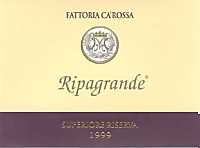
|
|
Sangiovese di Romagna Superiore Ripagrande 1999 |
|
| Fattoria Ca' Rossa (Italy) | |
| Grapes: Sangiovese | |
| Price: € 15,00 | Score: |
| The wine shows a brilliant ruby red color and nuances of orange/brick red, moderate transparency. The nose reveals intense, clean, elegant and pleasing aromas of black cherry jam, blueberry jam, blackberry jam, plum jam and dried violet followed by intense and good aromas of chocolate, black pepper and vanilla. In the mouth denotes good correspondence to the nose, a slightly alcoholic attack however well balanced by tannins, full body and intense flavors. The finish is persistent with clean flavors of plum jam, blackberry jam and black cherry jam. A well made wine. This Sangiovese ages in barrique for at least 12 months followed by a 6-12 months of aging in bottle. | |
| Food Match: Game, Roasted meat, Braised and stewed meat, Hard cheese | |
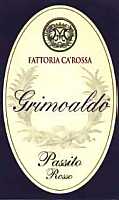
|
|
Grimoaldo 2001 |
|
| Fattoria Ca' Rossa (Italy) | |
| Grapes: Terrano | |
| Price: € 7,00 (500ml) | Score: |
| The wine shows a deep ruby red color and nuances of purple red, little transparency. The nose has good, intense, pleasing and clean aromas of black cherry jam, cherry jam, blueberry jam, blackberry jam, violet, chocolate and vanilla. In mouth has good correspondence to the nose, a tannic attack however well balanced, intense flavors and agreeable sweetness. The finish is persistent with flavors of blueberry jam and black cherry jam. Grimoaldo is fermented and aged in barrique. | |
| Food Match: Red berried fruit tarts, Hard cheese | |
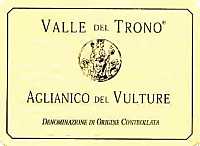
|
|
Aglianico del Vulture Valle del Trono 2000 |
|
| Basilium (Italy) | |
| Grapes: Aglianico | |
| Price: € 23,00 | Score: |
| The wine shows an intense ruby red color and nuances of ruby red, moderate transparency. The nose reveals intense, pleasing and clean aromas of black cherry, raspberry, blueberry, violet and carob followed by pleasing hints of chocolate, licorice, black pepper and tobacco. In the mouth has good correspondence to the nose, a slightly tannic attack however balanced by alcohol, intense flavors and good body. The finish is persistent with good flavors of raspberry, black cherry and plum. This Aglianico is produced with partially dried grapes and ages in cask for 24 months. | |
| Food Match: Roasted meat, Braised meat with mushrooms, Hard cheese | |
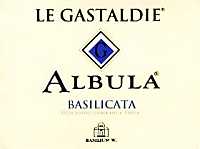
|
|
Le Gastaldie Albula 2001 |
|
| Basilium (Italy) | |
| Grapes: Aglianico | |
| Price: € 8,00 | Score: |
| This wine, produced with Aglianico grape vinified with white wine making process, shows a brilliant greenish yellow color and nuances of greenish yellow, very transparent. The nose reveals intense and pleasing aromas with a well balanced hint of toasted wood. There can be perceived aromas of acacia, citrus fruit, banana, broom, medlar, pear, peach and vanilla. In mouth reveals good correspondence to the nose, a slightly crisp attack however balanced and intense flavors. The finish is persistent with good flavors of peach, medlar and vanilla. | |
| Food Match: Soft cheese, Pasta and risotto with vegetables, Eggs, Sauteed white meat | |
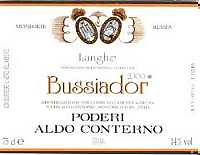
|
|
Langhe Chardonnay Bussiador 2000 |
|
| Poderi Aldo Conterno (Italy) | |
| Grapes: Chardonnay | |
| Price: € 22,00 | Score: |
| The wine shows an intense straw yellow color and nuances of straw yellow, very transparent. The nose denotes personality with intense, clean, elegant and pleasing aromas of acacia, banana, pineapple, hawthorn, apple, litchi, jasmine, grapefruit and hazelnut followed by intense and good hints of vanilla, coffee, butter and aromas of toasted wood. In mouth has good correspondence to the nose, good body, balance and intense flavors, agreeable crispness. A well made wine. The finish is persistent with good flavors of banana, pear, grapefruit and pineapple. This Chardonnay ferments in barrique and ages for 12 months in barrique. | |
| Food Match: Roasted fish, Stuffed pasta, Sauteed and roasted white meat | |
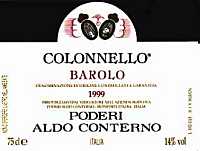
|
|
Barolo Colonnello 1999 |
|
| Poderi Aldo Conterno (Italy) | |
| Grapes: Nebbiolo | |
| Price: € 56,00 | Score: |
| This wine shows a light ruby red color and nuances of garnet red, moderate transparency. The nose has personality and intense, pleasing, elegant and refined aromas of black cherry jam, raspberry jam, plum jam and violet followed by good aromas of cocoa, leather, licorice, tobacco and vanilla. In mouth has good correspondence to the nose, an alcoholic attack well balanced by tannins, intense flavors and full body. The finish is persistent with clean flavors of raspberry, plum and cherry. A well made wine. Barolo Colonnello is aged for 26-28 months in cask. | |
| Food Match: Game, Roasted meat, Braised meat, Stewed meat, Hard cheese | |
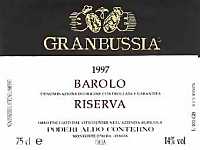
|
|
Barolo Granbussia Riserva 1997 |
|
| Poderi Aldo Conterno (Italy) | |
| Grapes: Nebbiolo | |
| Price: € 89,00 | Score: |
| A magnificent Barolo! This wine shows a beautiful and brilliant garnet red color and nuances of orange/brick red, moderate transparency. The nose reveals strong personality with intense, elegant, pleasing and very clean aromas of black cherry jam, strawberry jam, raspberry jam, blueberry jam, plum jam and dried violet followed by elegant and refined aromas of anise, cinnamon, chocolate, leather, licorice, mint, rosemary, thyme and vanilla. In the mouth has excellent correspondence to the nose, a slightly crisp attack however well balanced by alcohol, good and balanced tannins, intense flavors and full body. The finish is very persistent with long and clean flavors of plum, black cherry, blueberry and raspberry. A great wine. Granbussia riserva is produced only in the best years with wines from Romirasco, Cicala and Colonnello vineyards, ages for 26-28 months in cask followed by 6 years of aging in cellar. | |
| Food Match: Game, Braised and stewed meat, Roasted meat, Hard cheese | |

|
|
Verdicchio dei Castelli di Jesi Classico Le Vele 2002 |
|
| Terre Cortesi Moncaro (Italy) | |
| Grapes: Verdicchio | |
| Price: € 4,90 | Score: |
| The wine shows a brilliant straw yellow color and nuances of straw yellow, very transparent. The nose reveals intense, clean, pleasing and elegant aromas of citrus fruits, hawthorn, broom, litchi, apple, pear, peach and plum. In the mouth is balance since the very beginning, good body, intense flavors and good correspondence to the nose. The finish is persistent with pleasing flavors of peach, pear and plum. A well made Verdicchio. | |
| Food Match: Pasta and risotto with fish, Crustaceans, Roasted fish | |
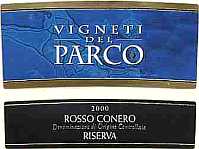
|
|
Rosso Conero Riserva Vigneti del Parco 2000 |
|
| Terre Cortesi Moncaro (Italy) | |
| Grapes: Montepulciano | |
| Price: € 12,00 | Score: |
| This Rosso Conero shows a beautiful and deep ruby red color and nuances of ruby red, little transparency. The nose reveals good personality with intense, clean, elegant, pleasing and refined aromas of black cherry jam, plum jam, blueberry, blackberry, black currant, violet and carob followed by pleasing and good aromas of licorice, chocolate, tobacco and vanilla. In the mouth has good correspondence to the nose, good balance and agreeable tannins, intense flavors and good body. The finish is persistent with clean and intense flavors of plum, black cherry and blackberry. A well made wine. This Rosso Conero ages for about 2 years in barrique and for at least 6 months in bottle. | |
| Food Match: Game, Roasted meat, Braised meat, Stewed meat, Hard cheese | |
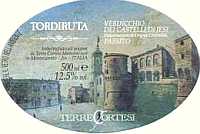
|
|
Verdicchio dei Castelli di Jesi Passito Tordiruta 2000 |
|
| Terre Cortesi Moncaro (Italy) | |
| Grapes: Verdicchio | |
| Price: € 17,20 - 500ml | Score: |
| The wine shows a beautiful and brilliant amber yellow color and nuances of golden yellow, very transparent. The nose reveals personality with intense, pleasing, clean, refined and very elegant aromas of dried apricot, candied fruit, quince jam, peach jam, almond, orange peel, honey and dried flowers followed by pleasing and intense aromas of caramel, enamel, vanilla and saffron as well as the pleasing and typical aroma of noble rot (Botrytis Cinerea). In the mouth has excellent correspondence to the nose, velvety and very agreeable with a well balanced sweetness, intense flavors and good structure. The finish is very persistent, almost endless, with clean and intense flavors of dried apricot, peach jam and quince jam. A great and very well made sweet wine. Tordiruta is produced with late harvested grapes affected by noble rot and dried in mats for 10 weeks, ferments and ages in barrique for 12 months followed by one year of aging in bottle. | |
| Food Match: Hard and piquant cheese, Fruit tarts, Strüdel | |
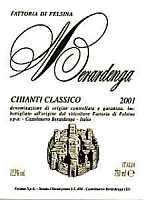
|
|
Chianti Classico 2001 |
|
| Fattoria di Felsina - Berardenga (Italy) | |
| Grapes: Sangiovese | |
| Price: € 14,00 | Score: |
| This Chianti shows a brilliant ruby red color and nuances of ruby red, moderate transparency. The nose reveals pleasing and clean aromas, mainly of fruit, such as black cherry, raspberry, blueberry, plum and violet followed by pleasing hints of vanilla. In mouth has good correspondence to the nose, a right quantity of tannins which make it very agreeable, intense flavors, good body and very balanced. The finish is persistent with flavors of plum, raspberry and black cherry. This wine ages in cask for 12 months followed by 3-6 months of aging in bottle. | |
| Food Match: Broiled meat and barbecue, Stuffed pasta, Hard cheese, Roasted meat | |
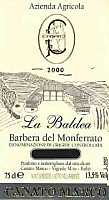
|
|
Barbera del Monferrato La Baldea 2000 |
|
| Canato Marco (Italy) | |
| Grapes: Barbera | |
| Price: € 7,50 | Score: |
| This wine shows an intense ruby red color and nuances of ruby red, little transparency. The nose reveals intense, clean and pleasing aromas of black cherry, cherry, blueberry, blackberry and plum followed by a pleasing hint of walnut. In the mouth has good correspondence to the nose, a slightly crisp attack however balanced, good body and intense flavors. The finish is persistent with good flavors of blueberry, black cherry and plum. This Barbera is aged for 12 months in steel tanks and for some months in bottle. | |
| Food Match: Roasted meat, Sauteed meat, Hard cheese | |
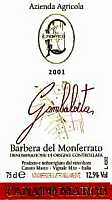
|
|
Barbera del Monferrato Gambaloita 2001 |
|
| Canato Marco (Italy) | |
| Grapes: Barbera | |
| Price: € 5,00 | Score: |
| This wine shows a brilliant ruby red color and nuances of ruby red, moderate transparency. The nose reveals pleasing, intense and clean aroma of fruits such as black cherry, raspberry, blueberry and plum followed by good aromas of violet and carob. In the mouth has good correspondence to the nose, a slightly crisp attack however balanced, good body and intense flavors. The finish is persistent with flavors of black cherry, raspberry and plum. This Barbera is aged in steel tanks and in bottle for some months. | |
| Food Match: Stuffed pasta, Sauteed meat with mushrooms, Roasted white meat | |
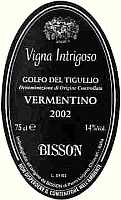
|
|
Golfo del Tigullio Vermentino Vigna Intrigoso 2002 |
|
| Bisson (Italy) | |
| Grapes: Vermentino | |
| Price: € 10,50 | Score: |
| This wine shows a brilliant greenish yellow color and nuances of greenish yellow, very transparent. The nose reveals pleasing, clean and elegant aromas of hawthorn, broom, acacia, banana, pineapple, apple, pear and peach. In the mouth has good correspondence to the nose, good balance, intense flavors and agreeable crispness. The finish is persistent with clean flavors of pineapple, pear and apple. | |
| Food Match: Dairy products, Boiled fish, Pasta and risotto with fish, Vegetable soups | |
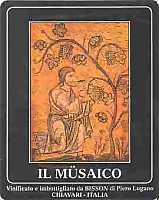
|
|
Il Müsaico 2001 |
|
| Bisson (Italy) | |
| Grapes: Dolcetto (70%), Barbera (30%) | |
| Price: € 13,20 | Score: |
| This wine shows an intense ruby red color and nuances of purplish red, moderate transparency. The nose reveals intense, pleasing, clean and elegant aromas of black cherry, blueberry, plum and violet followed by good aromas of chocolate, licorice and vanilla. In the mouth has good correspondence to the nose, good balance, intense flavors and good body. The finish is persistent with flavors of plum and blueberry. Musaico ages in cask for 12 months. | |
| Food Match: Roasted meat, Broiled meat and barbecue, Braised meat with mushrooms, Hard cheese | |
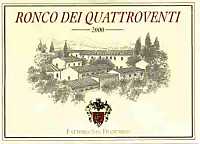
|
|
Cirò Rosso Classico Ronco dei Quattroventi 2000 |
|
| Fattoria San Francesco (Italy) | |
| Grapes: Gaglioppo | |
| Price: € 16,20 | Score: |
| The wine shows a beautiful and intense ruby red color with nuances of garnet red, little transparency. The nose has personality with clean, pleasing and elegant aromas of black cherry, blueberry jam, plum, black pepper, cardamom, chocolate and carob followed by pleasing and clean hints of eucalyptus, licorice and vanilla. In mouth reveals a good correspondence to the nose, a slightly tannic attack however balanced by alcohol, intense flavors and full body. The finish is persistent with clean flavors of black cherry, blueberry and plum. A well made wine. This red Cirò ages in barrique for 12-13 months. | |
| Food Match: Game, Braised and stewed meat, Hard cheese, Roasted meat | |
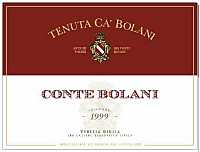
|
|
Conte Bolani 1999 |
|
| Tenuta Ca' Bolani (Italy) | |
| Grapes: Merlot (50%), Cabernet Sauvignon (30%), Refosco dal Peduncolo Rosso (20%) | |
| Price: € 19,50 | Score: |
| This wine shows a deep ruby red color and nuances of ruby red, little transparency. The nose denotes clean, pleasing, refined and elegant aromas of black cherry, strawberry, blueberry, plum and cyclamen followed by pleasing aromas of carob, chocolate, bell pepper and vanilla. In mouth reveals a slightly tannic attack however well balanced by alcohol, good correspondence to the nose, intense flavors and full body. The finish is persistent with pleasing and clean flavors of black cherry, raspberry and blueberry. A well made wine. Conte Bolani ages for 12 months in barrique. | |
| Food Match: Game, Braised and stewed meat, Hard cheese, Roasted meat | |
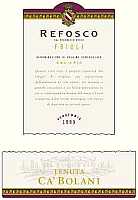
|
|
Friuli Aquileia Refosco dal Peduncolo Rosso 1999 |
|
| Tenuta Ca' Bolani (Italy) | |
| Grapes: Refosco dal Peduncolo Rosso | |
| Price: € 11,00 | Score: |
| The wine shows a deep ruby red color and nuances of ruby red, little transparency. The nose denotes clean, elegant and pleasing aromas of black cherry, blueberry, blackberry, plum and violet followed by clean aromas of carob, chocolate, licorice and vanilla. In mouth has good correspondence to the nose, a slightly tannic attack however well balanced by alcohol, intense flavors and full body. The finish is persistent with pleasing and clean flavors of black cherry, plum and blueberry. A well made wine. This Refosco ages for 12 months in barrique followed by at least 6 months of aging in bottle. | |
| Food Match: Roasted meat, Braised and stewed meat, Hard cheese | |

|
|
Moscato d'Asti 2002 |
|
| Castello del Poggio (Italy) | |
| Grapes: Muscat Blanc | |
| Price: € 7,70 | Score: |
| This wine shows an intense greenish yellow color and nuances of greenish yellow, very transparent. The nose reveals the typical aroma of Muscat grape as well as intense, clean and pleasing aromas of peach, apple, pear, citrus fruit, broom and sage. In the mouth has good correspondence to the nose, agreeable effervescence and good balance with very pleasing and balanced sweetness and crispness, intense flavors. The finish is persistent with good flavors of Muscat grape, peach and pear. | |
| Food Match: Cream dessert, Fruit salads, Semifreddo | |
Borgo di ColloredoIn one of the most picturesque areas of the Italian territory, Molise, twelve kilometers from Termoli is located Borgo di Colloredo winery. A union of history, traditions and wine |
|
The enological fame of Molise was known since ancient Roman times and Pliny the Elder, in its monumental Naturalis Historia, wrote about fertile slopes facing towards the Adriatic sea, near the ancient town of Cliternia, with a mild and tempered climate particularly suited to the cultivation of vine. In this area is located Borgo di Colloredo winery. In the 1960s, Silvio di Giulio, founder of the winery, bought an estate near Nuova Cliternia, forty five hectares of fertile land and particularly exposed to sun rays in a hill facing towards south-east, towards the Adriatic sea, a place full of promises for the best conditions of vine cultivation and wine production.
Slvio di Giulio, whose origins are from Tollo, Abruzzo, aware of the long family experience and of the historical wine traditions of its home land, he always had the idea of starting a project about specialized viticulture and, after having bought the Nuova Cliternia's estate, his dreams could finally turn into reality. The first project of the winery is dated back to 1968 and it was completed within the end of the 1970s. Passion for vine and wine was passed to his sons Enrico, winemaker, and Pasquale, agricultural cultivation specialist, who continued running the winery with enthusiasm. Di Giulio's brothers had the idea of introducing new local vine species in their winery and, at the beginning of the 1990s, they started the winery's restoration. This renewal introduced new vine species, including the white berried grapes Garganega, Malvasia Bianca and Falanghina, as well as the red berried grapes Aglianico, Merlot and Cabernet Sauvignon. The winery is also involved in experimental cultures and productions by using Chardonnay and Cabernet Sauvignon grapes. During the winery's restoration, the original machinery were renewed and introduced new ones according to the modern wine technologies. However di Giulio's brothers paid particular care to keep the precious cultural and traditional heritage of their lands whose history passed on to us up to nowadays. Also favored by the illustrious past of those places, di Giulio's brothers called their winery “di Colloredo”, in honor of an ancient building, destroyed in the sixteenth century, where it was subsequently built Madonna Grande Church having an octagonal base which is part of the winery's estates. As a matter of choice of the proprietors, the winery is considered an “open project” for their customers and the public, both for experts and simple tourists, the winery's doors are always open for them. According to a wider and continuing renewal project, the winery is working on the existing vineyards maintenance as well as planting new ones in the aim of starting a new project about viticultural zoning to be completed, according to the winery's plans, within four years. This project is based on the evaluation of the functional properties of the land while paying attention to the microclimate as well as to the different vine species cultivated in the estates. The goal of the project is to discover the potentialities of the land, related to every single vine species, in order to make wines whose quality is the result of the harmonic relationship between land and vine. This is an important leap forward in the aim of obtaining higher quality products, in respect to the properties and characteristics of the territory. All the factors influencing wine cultivation in relation to the effects and the characteristics of the territory are being analyzed, in order to better apply the best conditions capable of optimizing every resource. The project will have its natural development in the control of the results which make, as a matter of fact, the real goal of this research. The winery currently has a total capacity of 15,000 hectoliters (396,258 gallons) and is run in respect of quality and by the high level of the technologies used. No matter wine technologies are modern and sophisticated, this scrupulously meets the best criteria in respect of the typicality of products: from thermo-controlled vinification of must obtained by soft pressing, to maceration of must in skins for relatively long times for red wines, from stabilization to bottling, every phase of the production is controlled with particular care. Young wines are aged in steel tanks, whereas Gironia Biferno rosso and Aglianico Terre degli Osci age in oak casks and barriques.
Borgo di Colloredo production offers typical wines from Molise, both DOC (Denominazione di Origine Controllata) and IGT (Indicazione Geografica Tipica). Wines produced by the winery are currently exported for 70% in the European Union and Japan, whereas 20% is destined to the Italian market and the remaining 10% to Molise. Among white wines produced by Borgo di Colloredo, it is worth mentioning Biferno bianco Gironia, produced with Trebbiano Toscano, Bombino Bianco and Malvasia Bianca, an interesting interpretation of this renowned Molise's DOC, fermented and aged in steel tanks. Also interesting is Falanghina, one of the typical white berried grapes of the region, aged in steel tanks. Among white wines there is also a Trebbiano, direct and pleasing, aged in steel tanks, just like every other white wine produced by the winery. Among red wines produced by the winery, it is worth mentioning Sangiovese Terre degli Osci, aged in steel tanks, and Montepulciano, aged in steel tanks as well, both very pleasing and direct. Certainly interesting is Biferno rosso Gironia, produced with Montepulciano and Aglianico grapes, aged in cask for 12-18 months followed by 6 months of aging in bottle before being commercialized. Also Aglianico Terre degli Osci is an interesting and well made wine, with good body, exclusively produced with Aglianico grape, ages for three months in barrique followed by a further aging of 4-5 months in bottle.
|
||||||||||||||||
|
Score legend Prices are to be considered as indicative. Prices may vary according to the country or the shop where wines are bought |
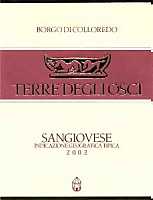
|
|
Sangiovese Terre degli Osci 2002 |
|
| Borgo di Colloredo (Italy) | |
| Grapes: Sangiovese | |
| Price: € 2,80 | Score: |
| This wine shows a brilliant purplish red color and nuances of purplish red, moderate transparency. The nose reveals pleasing and clean aromas of fruit such as black cherry, cherry, strawberry and raspberry followed by good aromas of geranium and violet. In the mouth has good correspondence to the nose, good balance, pleasing tannins, intense flavors and good body, agreeable. The finish is persistent with flavors of raspberry and cherry. | |
| Food Match: Sauteed meat with mushrooms, Stuffed pasta, Cold cuts | |
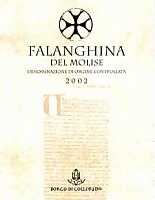
|
|
Molise Falanghina 2002 |
|
| Borgo di Colloredo (Italy) | |
| Grapes: Falanghina | |
| Price: € 5,80 | Score: |
| The wine shows a brilliant straw yellow color and nuances of straw yellow, very transparent. The nose denotes clean and pleasing aromas of citrus fruits, ripe banana, hawthorn, almond, apple and pear. In the mouth has good correspondence to the nose, a slightly round attack however balanced, intense flavors and good body. The finish is persistent with flavors of apple and pear. | |
| Food Match: Pasta and risotto with fish, Soft cheese, Sauteed fish, Crustaceans | |
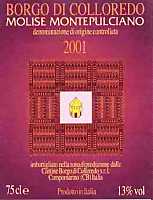
|
|
Molise Montepulciano 2001 |
|
| Borgo di Colloredo (Italy) | |
| Grapes: Montepulciano | |
| Price: € 4,20 | Score: |
| This wine shows an intense ruby red color and nuances of purplish red, little transparency. The nose mainly reveals pleasing fruity aromas, clean and intense, such as black cherry, cherry, strawberry, raspberry and plum followed by good aromas of geranium. In the mouth has good correspondence to the nose, good balance, with intense flavors and good body, very agreeable. The finish is persistent with flavors of plum, raspberry and black cherry. | |
| Food Match: Broiled meat and barbecue, Sauteed meat | |
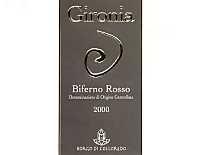
|
|
Biferno Rosso Gironia 2000 |
|
| Borgo di Colloredo (Italy) | |
| Grapes: Montepulciano (75%), Aglianico (25%) | |
| Price: € 7,50 | Score: |
| This wine shows a deep ruby red color and nuances of garnet red, little transparency. The nose reveals intense, clean and pleasing aromas of black cherry, blueberry, plum, carob and dried violet followed by good aromas of licorice and vanilla. In the mouth has good correspondence to the nose, a slightly tannic attack well balanced by alcohol, intense flavors and good body. The finish is persistent with good flavors of plum, black cherry and blueberry. This wine ages in cask for 12-18 months followed by 6 months of aging in bottle. | |
| Food Match: Roasted meat, Sauteed meat with mushrooms, Hard cheese | |
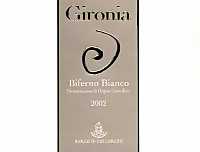
|
|
Biferno Bianco Gironia 2002 |
|
| Borgo di Colloredo (Italy) | |
| Grapes: Trebbiano Toscano (70%), Bombino Bianco (25%), Malvasia Bianca (5%) | |
| Price: € 5,80 | Score: |
| The wine shows an intense straw yellow color and nuances of straw yellow, very transparent. The nose reveals intense, clean and pleasing aromas of citrus fruits, hawthorn, apple, honey, hazelnut, pear, peach and plum. In the mouth has good correspondence to the nose, a pleasing crisp attack however well balanced by alcohol, intense flavors and good body. The finish is persistent with pleasing flavors of pear, apple and plum. | |
| Food Match: Pasta and risotto with fish, Soft cheese, Broiled fish, Crustaceans | |
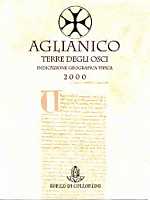
|
|
Aglianico Terre degli Osci 2000 |
|
| Borgo di Colloredo (Italy) | |
| Grapes: Aglianico | |
| Price: € 6,40 | Score: |
| This wine shows a brilliant ruby red color and nuances of garnet red, moderate transparency. The nose denotes intense, clean and pleasing aromas, mainly of fruit, such as black cherry, cherry, strawberry, raspberry, blueberry and plum followed by good aromas of carob and vanilla. In the mouth has good correspondence to the nose, a slightly tannic attack however well balanced, intense flavors and good body. The finish is persistent with clean flavors of black cherry, raspberry and plum. Part of this Aglianico ages in barrique for 3 months followed by 4-5 months of aging in bottle. | |
| Food Match: Roasted meat, Broiled meat and barbecue, Braised meat with mushrooms, Hard cheese | |
| Cantine Borgo di Colloredo - C.da Zezza, Loc. Nuova Cliternia - 86042 Campomarino (Campobasso) Tel. 0875 57453 Fax 0875 57110 - Winemaker: Enrico Di Giulio - Established: 1994 - Production: 300.000 bottles - E-Mail: info@borgodicolloredo.com - WEB: www.borgodicolloredo.com |
Cellar Journal |
|
This section is reserved to wine producers who want to publish news and information about their business, to announce new products or just for communicating to their customers information and promotions about their products and activity. Send news to be published at our e-mail address.
|
News |
|
In this section will be published news and information about events concerning the world of wine and food. Whoever is interested in publishing this kind of information can send us a mail at our address.
|
Matching Food with Red WinesRed wine has always had a relevant place in the table, companion of the rich and robust food, it is rich of nice surprises and it can also become a good ally of fish |
|
When one thinks about red wine in a table adorned by foods, it is almost impossible not to imagine succulent roasted meat, game, tasty cheese and elaborated recipes. Perhaps this is also the reason why red wine is considered the “wine par excellence”, the real one, the image of a rich and tasty cooking probably makes it appear more important than others. However there are not just full bodied and robust red wines, the ones, to tell the truth, considered more important than others, often they are so robust which is almost impossible to match to any food, and there is also a countless family of light and less structured reds that, besides being pleasing to drink, are very versatile and useful in the matching of foods. Thanks to the richness and vastness of gastronomical cultures of the world, made of rich and tasty foods, as well as lighter and less elaborated foods, it is possible to discover, or better to say, to rediscover, the agreeability of those red wines, wrongly considered as “lesser”, because of the lacking of important structures they are often considered lightly. Thanks to these light red wines, fresh and pleasing, it will be even possible to try one of the most unusual matching known, that is the type of matching, according to one of the most common senses, which needs white wine: fish.
|
|
Red wine is currently the most produced one and the most demanded style from consumers and every country offers a wide and rich possibility of choices, from light and fresh red wines to robust and bodied wines. The grapes mainly used for the production of red wines are the so called “international” ones, in particular Merlot and Cabernet Sauvignon, which are found, alone or together with other grapes, in a very high number of red wines. Whether the reason of this trend is because of the effect of a fashion or because of their real qualities, it is hard to say, however the temptation to say it is because of a fashion is pretty strong. Anyway every wine producing country of the world can offer a wide selection of local red grapes which are not anything less than the others, for example the richness of Italy with its Sangiovese, Aglianico and Nebbiolo, just to mention few, as well as Spain with its excellent Tempranillo, and United States of America with Zinfandel. Of course, no one dares to deny the greatness of “international” grapes, however according to a cultural point of view, it is certainly interesting, and useful, to know the rich heritage of red wines produced with less known grapes.
The selection of red wines produced in France is surely rich and excellent, after all French red wines have been used as a reference model in every wine country of the world. Among French regions which produce wine, Bordeaux, Bourgogne and Rhône Valley are the ones having a primary importance. The region of Bordeaux, famous in every place of the world since centuries for its red wines, produces robust and elegant reds mainly with Cabernet Sauvignon, Cabernet Franc and Merlot grapes. Bordeaux's reds are very suited for the matching of elaborated and rich foods as well as with cheese. In Bourgogne, another excellent region producing red wines, is Pinot Noir grape to play the most important role of the scene: very elegant, refined and rich wines, examples of great class which can be hardly compared to the rest of the world. South from Bourgogne there is Beaujolais where red wines are produced with Gamay grape, fresh and fruity, these are wines to be drunk young and have an interesting use in the food matching. Going towards south there is the Rhône Valley, homeland of the Syrah grape, renowned for its excellent Hermitage, Côte Rôtie and Saint-Joseph, as well as for Châteauneuf-du-Pape which can be produced with even 13 different grapes. Another interesting grape of this region is Mourvèdre used to make particularly rich and spicy wines. Even French Provence offers a wide selection of red wines produced with Grenache Noir, Cinsaut and Carignan, as well as Bandol, a red produced with Mourvèdre grape. Among the other interesting areas for the production of red wines should be mentioned Savoie for its wines made with Mondeuse grape, and Corsica with its wines produced with Nielluccio and Sciacarello grapes, as well as Languedoc-Roussillon for its Vin de Pays. Also Italy offers a rich selection of red wines, from north to south, vineyards are joyously colored by red bunches. Every Italian region has local red berried grapes capable of producing excellent wines for food matching, from light wines, with fresh and fruity aromas, to bodied and robust wines, with more complex and austere aromas. Vallée d'Aoste offers a good selection of red wines, in particular Donnas, Enfer d'Arvier, Torrette and Arnad Monjovet. Here are cultivated interesting local red grapes, such as Petit Rouge, Fumin, Neyret and Vien de Nus. Piedmont, associated to red wines since ever, in particular for Barolo and Barbaresco, as well as the less known, and certainly to be valued, Gattinara and Ghemme as well as the excellent Ruchè di Castagnole Monferrato. In this region the main grapes are Nebbiolo and Barbera, anyway it is worth mentioning Dolcetto, Freisa and Grignolino. In Liguria are found interesting reds made with local grapes, such as Rossese di Dolceacqua and Ormeasco, name used in the region to refer to Dolcetto, as well as wines produced with Sangiovese and Ciliegiolo. Red wines of Lombardy are pretty different: to the north dominates Chiavennasca, name used here to refer to Nebbiolo and used to produce the excellent Valtellina's wines, whereas in the south, in the Oltrepò Pavese, Barbera and Croatina, as well as international grapes, are the ones mainly cultivated. Moreover, a special mention should go to the excellent wines of Franciacorta, partly produced with Nebbiolo and Barbera, as well as the wines from the area of Garda lake produced with Groppello and Marzemino grapes. In Veneto the leading role is played by the rich Amarone, produced with Corvina, Rondinella and Molinara grapes, however there should also be mentioned other interesting wines produced in the region with Oseleta, Raboso, Marzemino and Pignola grapes. Alto Adige offers great wines produced with Lagrein grape as well as those produced with Schiava, and in particular, the ones produced with Pinot Noir. Also Trentino offers wines produced with Schiava grape as well as with Marzemino, however the most interesting grape of the region certainly is Teroldego. In Friuli Venezia Giulia, as well as wines produced with international grapes, there also are excellent red produced with Refosco dal Peduncolo Rosso and Schioppettino. Emilia Romagna offers a good selection of red wines, including the renowned Lambrusco, lively and joyous, as well as more austere wines produced with Sangiovese. This grape is also present in Tuscany and it is used for the production of the famous Chianti and Brunello di Montalcino. In the region are also produced excellent wines such as Nobile di Montepulciano, Carmignano and Morellino di Scansano. In Umbria is the Sagrantino grape, with its powerful wines, to play the most important role, however the region also produces excellent red wines such as Torgiano, Colli Amerini and Colli del Trasimeno, where Sangiovese grape is found. In the Marches are Rosso Conero and Rosso Piceno the most representative wines, both produced with Montepulciano and Sangiovese grapes. Latium offers an interesting local grape, Cesanese, which should be valued more, as well as wines produced with Sangiovese and Montepulciano. Montepulciano grape is the queen of the excellent red wines produced in Abruzzo, a grape which is virtually found in every wine produced in the region. Molise, which is getting more and more renowned, produces red wines with Montepulciano, Sangiovese and Aglianico. Aglianico, superb grape of south Italy, is also found in Campania and it is used to make the renowned Taurasi, and another interesting grape of the region, although less famous, is Piedirosso. Aglianico is also the most important red berried grape of Basilicata, with this grape are produced the excellent wines of the Vulture. In Apulia are found two grapes of primary importance and used to make great wines, Negroamaro, in particular in the Salento area, and Primitivo, in the area of Manduria. Groppello is the main red berried grape of Calabria where Cirò is the most representative wine, however the region also produces an interesting but less known wine: Savuto. In Sicily is the Nero d'Avola grape to be considered the most important one for the island's enology: powerful, rich and complex wines. Also interesting the wines produced with Frappato grape. Cannonau is the most important red berried grape of Sardinia, however in the island are also produced interesting wines with Carignano, Bovale, Monica and Nieddera grapes. In Spain is the excellent Tempranillo the grape to dominate the enological scene of red wines, however are also produced excellent wines with Cariñena, Garnacha Tinta, Graciano and Monastrell grapes. Rioja, Ribera del Duero and Priorato are the main areas where the excellent red wines of Spain are produced and that can be used with success for food matching. Also red wines from Portogallo are very interesting, in particular the ones produced in the Douro region, homeland of the renowned Porto. Among the most interesting red berried grapes there are Tinta Bairrada, Tinta Negra Mole, Periquita, Tinta Roriz, name used in Portogallo to refer to Tempranillo, Touriga Francesa and Touriga Nacional. Outside Europe the selection of red wines is interesting as well. In Australia are produced excellent red wines with Syrah grapes, here known as Shiraz, and other “international” grapes such as Cabernet Sauvignon and Merlot, in particular in the Barossa valley and Coonawarra areas. New Zealand, characterized by a production based on international grapes, offers good wines made with Cabernet Sauvignon, Merlot and Pinot Noir grapes. In South Africa must be mentioned, first of all, red wines produced with the local Pinotage grape, as well as wines produced with Cabernet Sauvignon, Merlot and Syrah, also here known as Shiraz. Among the regions to be mentioned there are Paarl and Stellenbosch. In the countries of the American continent, the grapes mainly used for the production of red wines are international. In the United States of America are produced excellent wines with Cabernet Sauvignon and Merlot, as well as with the local Zinfandel, in particular in California, and the excellent wines produced with Pinot Noir from Oregon. In Chile and in Argentina the production of red wines is based on international grapes, in particular Merlot and Cabernet Sauvignon.
|
||||||||||||
|
Matching red wine, as well as for any other style of wine, requires the knowledge and the evaluation of the specific organoleptic characteristic about the wine to be matched. Contrary to other wines, in reds is found an organoleptic element that, besides being essential for wine's balance, is responsible for the tactile sensation of astringency: tannin. This element, naturally present in skins and usually passed to wine from casks during the aging period, whose presence, in particular the intensity of the astringent sensation, represents a factor of primary importance when a food is chosen for matching. In red wines, besides tannins responsible for astringency, there also are other elements common in other types as well: alcohol, acidity, sweetness and body; elements that, considered alone, have a determinant role in choosing foods. Acidity in red wines is usually low, an essential condition for a good balance, as acids and tannins tend to exalt one each other, therefore an acid wine cannot be tannic and vice versa. However acidity becomes clearly perceivable and important in some young and fresh wines, produced with grapes having a low content in tannins and not aged in cask, and besides allowing a lower serving temperature, they also allow the matching with those foods where the presence of tannin would cause an unpleasing tasting sensation, such as fish. One of the most common beliefs of the matching red wine with food is about fish. It is commonly believed fish should never be matched to red wine, indeed the two can make excellent matchings. The main reason red wine is not chosen for the matching with fish is the “metallic” taste, usually unpleasant, probably caused by a chemical reaction between phosphates present in fish and traces of iron bound to tannins, in particular pigments. This would explain the reason why tannic wines are usually unpleasant with fish, but this also shows that red wines not containing tannins, and there are so many out there, can be happily matched to fish. Wines produced with Pinot Noir, Freisa and Grignolino grapes are just few of the many red wines that can be matched to fish. Tannin is however useful for balancing the succulent sensation caused by salivation because of foods rich in proteins, such as meat and cheese, therefore tannins, by binding with food's proteins, will diminish salivation. Even alcohol has a similar action, because of the pseudo caloric sensation of burning, however its main role is to cleanse unctuous substances from the mouth, generally used for the preparation of rich and elaborated recipes based on meat. Acidity, despite it is less perceivable in red wines as opposed to white or rose wines, will have the useful effect of balancing the taste of fatty ingredients and the ones basically having a sweet taste, such as fatty meat, fat basically has a sweet taste, as well as recipes based on pasta and starches. In mature red wines, when the astringency of tannins becomes milder and softer, it will be possible to perceive an increased and agreeable roundness, an organoleptic quality very useful with tasty foods and basically acid or bitter foods, such as roasted or broiled meat. Taste olfactory persistence, abbreviated as PAI, is useful with foods having a similar sensorial quality as well as with foods enriched with spices and aromatic herbs, a characteristic often found in rich recipes based on meat, such as braised and stewed meats. A factor that should not be neglected is wine's body, light red wines will be matched to light and simple foods, whereas robust and full bodied wines will be matched to rich and elaborated foods. Thanks to this rule it can be understood that red wine is not always to be matched to rich and elaborated foods, this style of wine can also be happily matched to light and simple recipes, such as fish as well as to many recipes based on pasta or cereals.
|
WhiskyOne of the most famous spirits of the world, exclusively produced by the fermentation of cereals, is a liquor rich in traditions and history |
|
|
|
The origins of whisky are not clear and they get lost in time. Going back to traditions, every information lead to the regions of Scotland and Ireland. It is plausible to believe that in those regions, where the cultivation of cereals is very common, someone thought of distilling the liquid where fermented barley boiled. Moreover, it is natural to think the discovering of a new beverage, inebriant, agreeable and pleasing in the cold winter nights, was shared with friends and originating an evolution process which will pass the beverage up to now. R.J. Fobes, a German expert of the history of distillation, said once it was believed that near Cashel, among the rests of Celtic-Irish buildings, there were parts of an ancient bronze made still. It is said that when Henry II of England invaded Ireland, he found out in those places was practiced the technique of distillation already.
It is more likely that the art of distillation was introduced in Ireland from Scotland during the middle age, however there is not any evident fact that can support this hypothesis. It can be however said, with no doubt, that both Irish whiskey and Scotch whisky share centuries of traditions. The first document where a spirit distilled from barley in Scotland is first mentioned is a register found in 1494, where it is mentioned the shipping of “eight boll of malt to monk John Corr to make brandy” name corresponding to the Gaelic “Uisge beatha”, that in Irish Gaelic becomes “uisce beathadh”. The most ancient term is the one used by Celts: “Usquebaugh”. It should be noticed this first citation is referred to a religious, this should make understand the importance of abbeys and monasteries that with their agricultural activity, were of fundamental importance to the development of distillation techniques, the production of beer and wine. These activities were practiced in the abbeys and monasteries of England, whereas the production of beer was practiced everywhere, distillation of cereals was only practiced in the northern area. During the sixteenth century in Scotland and in England were abolished monasteries and monks were forced, in order to make a living, to get the best benefits out from their monastical life: distillation techniques slowly spread everywhere in the country. The spreading was so vast that Scottish Parliament, in 1579, set specific laws that prohibited the distillation of brandy, with the exception of noblemen that could distill liquors for personal use. This norm was needed, not because the sobriety of the people was in danger, but because the activity of distillation subtracted cereals destined for nutrition. Charles I, in 1644, introduced new taxes, and this inspired the Scottish Parliament to do the same and therefore introduced new taxes on aqua vitae. In the 1600s and 1700s, usque baugh was both connected to Ireland and Scotland. Another witness dated back to the end of seventeenth century is offered by Martin Martin who, during its journeys in the Hebrides, wrote in his diary: “there are many type of liquors, usually called Usquebaugh, and also known as Trestarig, that is aquavitae, distilled three times, which are strong and hot” and ”a third type of liquor is distilled four times, and this is called Usquebaugh baul by locals: the first sip shakes the body and two spoonfuls are just a sufficient dose; every man who exceeds this dose, his breathing can suddenly stop and put his life in danger”. After some years from the constitution of the United Kingdom, the Union Act, the Parliament tried to make Scottish laws similar to the ones of England by introducing new taxes on malt, this was cause of tumults of the people and the Parliament was forced to abrogate the norm. A second attempt to tax malt was introduced in 1725, once again this was cause of tumults. At the end the Parliament won over people and was successful in introducing a new tax on malt and it even forbade the distillation for personal use. In 1784 was promulgated the Wash Act, which distinguished Lowlands and Highlands and supported producers of Highlands who had higher difficulties in the production of whisky as opposed to the ones of Lowlands. This law generated a flow of whisky from north to south and forced the Parliament to augment the tax for the permission of distilling. Moreover, to make distillers' life more complicated, there also were prohibition times because of the low availability of cereals because of famine. In 1814 London decided to set a new way. After having abandoned the old system of taxing the capacity of the still, they preferred a fixed tax of 10 pounds for every still. Despite this new measure, smuggling remained common and continued to develop forcing the parliament to change, once again, the laws which did not have the effect of changing Scottish feelings who continued to consider an interference the intentions of London for the reunification of the country.
|
||||||||||||
|
We will consider the production method used for Scotch whisky, the other ones are basically the same. The ingredients are barley, yeast, water and peat. The distillation is usually done between October and May, byproducts of distillation are never wasted, and according to Scottish tradition, they are used for feeding animals. The process originates from barley: in the beginning only local barley was used, but now, since tens of years, also imported barley is used; this factor should be useful in understanding the quality of Scotch whisky does not depend on the barley used for production. The same thing cannot be said for the other two ingredients, water and peat, which prove to be the most important ingredients for the quality of whisky. The first phase of the process is about transforming barley into malt. Malt consists in germinated barley by using a process of maceration in water, therefore, by means of heat, it gets dried. This process begins with maceration, consisting in wetting barley in tanks called “steeps”, in order to start germination, the temperature is held at about 20° C (68° F). Maceration time varies according to the weather and to the quality of barley, usually ranging from 48 to 72 hours. When the weight of barley is raised to one time and a half, the water is drained, and it is laid on the floor, from this moment on the germination process takes place and starch get transformed into maltose. At the end of the process, barley is transformed into green malt and it is finally ready to be dried and to be transformed into sugar. Green malt is rich in water and it must be dried in a peat operated oven called “Kiln”, in order to lose water. Green malt is laid at a height of about 60 centimeters from the base of the oven (23 inches), and then peat it is burned under it. Peat's smoke, by raising up, passes through the base and dries the malt while impregnating it with its characteristics aromas. At the end of the drying process the malt is being cleaned, then it is milled and the resulting flour is blended with water at a temperature of about 60° C (140° F), the so called “mashing”, until it gets transformed in sweet must, called “wort”. Malt is extracted three or four times at different temperatures, from 70° to 80° C (158°-176° F). The next phase of the process is fermentation. The must is passed through a refrigerator and its temperature is lowered to 20° C (68° F) and subsequently passed in wash-backs, large fermentation tanks, where along with the must is also added beer yeast and soon after the fermentation starts. Yeasts allow the extraction of dextrose from maltose and therefore convert dextrose into alcohol and carbon dioxide. It is a violent and noisy process, lasting from 36 to 40 hours, and the result is a clean liquid, which is called wash, made of water, yeast and alcohol (about 5%). The wash is a fermented liquid ready to be distilled. The next phase is distillation: it is in this stage that whisky is obtained. Malt Scotch whisky from Highlands it is still distilled in copper made stills called “Pot still”. Every distillery must have at least two stills, one for the first distillation, having a larger neck and used for the production of the so called “low wines”, and another, the “low wines still”, also called “spirit still”, for the second distillation. As “head” and “tail” are being discarded, they contain poisonous substances, it is obtained the “heart” (middle cut) which finally is “malt whisky”. In these last phases it is fundamental the skill of the stillman, that is the one responsible for the distillation process: it is him the one who decides whether the liquid coming out from the still is quality whisky or not. Besides experience, stillman does some tests by adding water to the liquid obtained by distillation: in case it gets turbid it means quality is still low, only when the liquid stays limpid is considered whisky. Making whisky is certainly an art: even the least error during the distillation process could compromise the whole quality of the beverage. Distilled whisky has an alcohol by volume ranging from 57% and 60%, moreover, it is highly burning in the mouth and has a sour taste, it practically is undrinkable. Water is then added in order to low the alcohol by volume down to 40%-43%. Water is fundamental, it is what will make whisky inimitable. After this phase the whisky is transferred in casks, usually having a capacity not greater than 185 gallons and they are kept in rooms controlled by officers of her Majesty. At this point begins the aging process. Scotch whisky, by law, must be aged for at least 3 years. At the end of this period whisky is still immature and at least 6 years must be waited before tasting a decent product. Optimal aging is obtained after ten years. Despite aging depends on the size of cask, not all whisky age at the same way: the ones from Highlands age slowly and are more longeval when compared to the ones of Lowlands and Campbeltown. During aging part of the volume and strength is lost according to the humidity of the aging rooms: the higher the humidity, the more the whisky will lose strength; the lower the humidity, the higher will be the loss of volume. Usually casks used for the aging of Sherry, when used for the aging of whisky, are capable of giving roundness and personality, as well as a splendid golden color. Sherry gives whisky roundness and sometimes part of its aromas as well. Casks used for sherry are not the only ones used for aging whisky, some distilleries use cask of Bourbon, Port and Amontillado. At the end of the aging period, before proceeding to bottling, a further reduction of the alcohol by volume is usually done and this will obtain a whisky with 40%-45% of alcohol by volume. Special whisky called “cask proof” are also sold, this whisky is not diluted and has the same alcohol by volume of the cask, about 57%. 95% of the commercialized whisky is a blend, that is a blending of more whiskys, and it is the blender the one who creates blends by selecting strong young whiskys and older complex whiskys, creating a new product with a specific personality.
|
|
There are five big families of whisky: Scotch, Irish, Bourbon, Rye and Canadian. Whisky is also classified as:
Single malts are classified as:
Among the many types of whisky should also be mentioned:
Whisky or whiskey? The difference between whisky and whiskey is fundamental: whisky is the one traditionally produced in Scotland whereas whiskey is the one produced in Ireland. There are other differences as well. In Scotland barley is dried with peat's smoke, which also gives malt smoky aromas and will be found in the final product. In Ireland malt is being dried in closed ovens, therefore its taste is not contaminated and keeps the typical aromas of malt and honey. Another difference is that in Ireland whiskey is distilled three times in order to have a more pure and round beverage, in Scotland whisky is usually distilled two times.
|
|
Whisky is very versatile and can be drunk the way one likes the most. Drunk plain or with a glass of water, or with ice (on the rocks) but also by adding soda, mineral water, lemonade, ginger ale or other nonalcoholic beverages. Because of the versatility of whisky, it is a fundamental ingredient in many cocktails. In Scotland it is traditionally drunk before lunch or dinner or at late night, as an aperitif with some water. Some support the idea water must not be mineral and it must be pure spring water because mineral water has its own taste that would alter the one of whisky. Whereas wine tasters use bread to cleanse the mouth, whisky connoisseurs use hard cheese with a non aggressive taste, or bitter chocolate with water. Malts does not improve with the adding of ice, either “on the rocks” or plain water. A good way is to take little sips, after having smelt it, and leaving the beverage for few seconds between the tongue and the palate, alternating sips of water and lemon. This will be useful for rounding the aggressivity as well as amplifying and prolonging both the taste and flavor of whisky.
|
Wine Parade |
|
|
| The best 15 wines according to DiWineTaste's readers. To express your best three wines send us an E-mail or fill in the form available at our WEB site. |
| Rank | Wine, Producer | |
|---|---|---|
| 1 |
| Masseto 1998, Tenuta dell'Ornellaia (Italy) |
| 2 |
| Capo di Stato 1998, Conte Loredan Gasparin (Italy) |
| 3 |
| Colli Bolognesi Pignoletto Superiore “Prova d'Autore” 2001, Bonfiglio (Italy) |
| 4 |
| Teroldego Rotaliano Granato 1998, Foradori (Italy) |
| 5 |
| Sauvignon Blanc 2000, Cakebread (USA) |
| 6 |
| Franciacorta Cuvée Annamaria Clementi 1996, Ca' del Bosco (Italy) |
| 7 |
| Château Laroque Saint-Émilion Grand Cru Classè 1998 (France) |
| 8 |
| Shiraz 2000, Plantaganet (Australia) |
| 9 |
| Fumé Blanc Napa Valley 2001, Grgich Hills (USA) |
| 10 |
| Château Lynch-Bages Pauillac 2000 (France) |
| 11 |
| Semillon Sauvignon 2001, Cape Mentelle (Australia) |
| 12 |
| Margaux 2000, Ségla (France) |
| 13 |
| Riesling Adelaide Hills 2001, Nephente (Australia) |
| 14 |
| Pinot Noir 1998, Mountadam (Australia) |
| 15 |
| Venere Maule Valley 2000, Cremaschi Furlotti (Chile) |
| |||||||
Privacy Policy | |||||||


| Copyright © 2002-2024 Antonello Biancalana, DiWineTaste - All rights reserved |
| All rights reserved under international copyright conventions. No part of this publication and of this WEB site may be
reproduced or utilized in any form or by any means, electronic or mechanical, without permission in writing from DiWineTaste. |